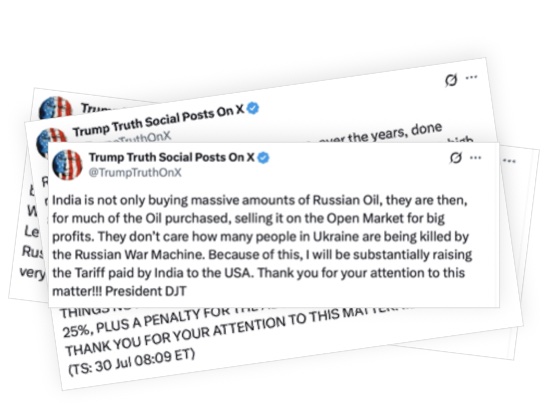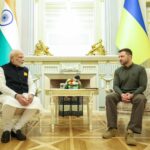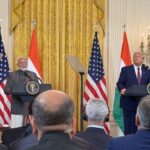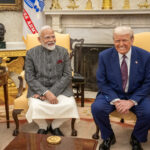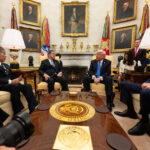Not everything in foreign policy starts and ends with a social media post; and there could not be a better example than what is happening in India-United States relations that to many is on a deep dive. “Looks like we’ve lost India and Russia to deepest, darkest China. May they have a long and prosperous future together,” President Donald Trump wrote on his Truth Social. This after images were repeatedly splashed by global media houses of the leaders of China, Russia and India seen huddling at the Shanghai Cooperation Organisation summit in Tianjin.
But at a presser at the White House subsequently, the President also maintained: “I don’t think we have. I’ve been very disappointed that India would be buying so much oil from Russia. I let them know that. We put a very big tariff on India- 50 per cent, a very high tariff. I get along very well with (PM) Modi, as you know. He was here a couple of months ago, in fact, we went to the Rose Garden and had a press conference.”
President Trump’s back and forth on India had very little to do with political and media pundits taking the Republican administration to the cleaners for throwing away a relationship that had been carefully built since the time of President Bill Clinton. What irritated many was the fact that President Trump was trying to humour Pakistan and trying to bring back the long discarded hyphenation in relations that had been carefully worked out since the times of President George W Bush. There are those who have taken pains to argue that there is nothing strategic in Washington’s current posturing towards Islamabad; rather a short term crypto currency outlook based on family interests.
Ironically the charge against the Trump administration’s India policy has come from top former officials of the Biden administration, National Security Advisor Jake Sullivan and Deputy Secretary Kurt Campbell who have maintained that the partnership between India and the United States has “effectively disincentivised reckless Chinese adventurism” in the Indo- Pacific.
“As [Prime Minister Narendra] Modi’s chummy appearance over the weekend with Chinese President Xi Jinping and Russian President Vladimir Putin made clear, the United States could end up driving India directly into its adversaries’ arms,” the duo wrote in Foreign Affairs making the point that New Delhi would be squeezed on all sides—on the border with China and over strained technology, education and defence relations with the United States.
The intentions of former senior officials are undoubtedly well placed in the context of what is at stake in bilateral relations; but to give a complete pass to the previous regime on its fumbled Ukraine and Russian oil sanctions policies cannot be ignored as much of the blame now is on the doorsteps of India by way of the 50 percent tariff. The Trump administration is complaining that India continues to buy cheap oil from Russia and its imports have dramatically gone up after the outbreak of the Russia-Ukraine conflict. Worse, some senior officials have maintained that India is making a profit by re-selling.
That any nation would seek to serve the interests of its people is a cardinal principle of international relations and foreign policy; India did too keeping in mind that its oil dependence is around 85 percent. Conveniently forgotten in all the fuss is the United States encouraging India and China to tap the Russian oil market with a view to keeping market prices stable. Also in April 2024, the Biden administration was asking Ukraine to stop attacking Russian oil refineries as it was impacting capacity. Writing for the Hudson Institute, Thomas Duesterberg argues, “In an election year, the Biden administration’s policy clearly values domestic fuel-price stability over helping Ukraine in its war for survival. The stated purpose of the U.S.-led price cap and ban on Russian exports to the West is to maintain Russia’s supplies while reducing the income from its exports without causing a price spike by taking Russian oil off the world market.”
President Trump’s walking back on having “lost” India to China and subsequently saying “I don’t think we have” is a clear indication that neither the last word on tariffs nor the future of bilateral ties. The fact that Narendra Modi did not go to the 80th Anniversary of the end of World War Two or travelling to Brazil for a BRICS meet on American trade measures should be indicators of the Indian Prime Minister’s thinking of perhaps not wanting to precipitating matters. The same goes as far as travelling for the United Nations General Assembly sessions starting later this month. Going to New York and coming away without meeting President Trump would not be the best diplomatic signal.
In all this hoopla over India being “lost,” there is something for students of political science and international relations. “Lost” is a dreaded word for Republicans and Democrats who were in the White House or aspired to sit in the Oval Office.
Questions of who “Lost” Korea started it all in the post World War Two era; and terrified American Presidents did not want to get into history books as the one who “lost” Vietnam; then came Afghanistan, Iraq, and so on. But a smart businessman-turned politician like President Trump also knows one thing: to lose something means you should have had it to start with! When did America “have” all of the above?
Disclaimer: The opinions and views expressed in this article/column are those of the author(s) and do not necessarily reflect the views or positions of South Asian Herald.


